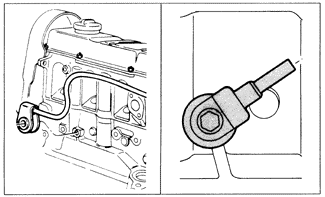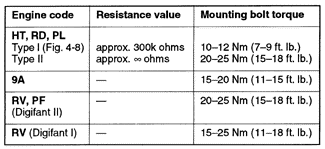4.5 Checking and Replacing Knock SensorThe knock sensor detects the unusual engine vibrations caused by detonation, often referred to as knock or ping. The knock causes the sensor to generate a low-voltage signal which is monitored by the knock sensor control unit (on CIS-E), the Digifant control unit, or the Motronic control unit. The control unit retards ignition timing electronically in small steps until the detonation ceases. If the ignition timing advance is incorrect or if the engine seems to lose power, the knock sensor should be the first component investigated. If the knock sensor is not faulty, continue troubleshooting with 4.6 Troubleshooting Knock Sensor System. A number of different knock sensors are used on engines covered by this manual, and each has a different torque specification. Correct mounting bolt torque is critical to knock sensor operation. Too much mounting bolt torque may crush the sensor crystal, while too little torque may prevent the sensor from reacting to the knock. In either case, the control unit will go into default mode and severely retard the timing to prevent engine damage. This will be seen as a noticeable loss of engine power. The sensor type must be identified prior to installation so that the correct installation torque can be used. On engines with CIS-E fuel injection (engine codes HT, RD, PL) there are two possible knock sensors that may be installed. See Fig. 4-8.

A knock sensor that is suspected of being faulty should first be checked for correct installation torque, and, if possible, for resistance. Disconnect the sensor harness connector and use an ohmmeter to test for resistance between the two terminals of the knock sensor. Table i lists the tightening torques and resistance values for the sensors. It is also advisable to check a new knock sensor with an ohmmeter prior to installation. If it becomes necessary to replace the knock sensor or to remove it for other repair work, the following cautions should be observed. Table i. Knock Sensor Specifications
CAUTION-
|
